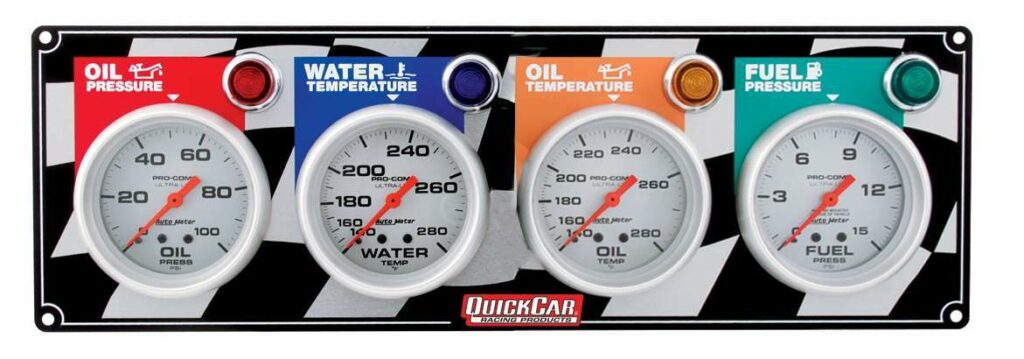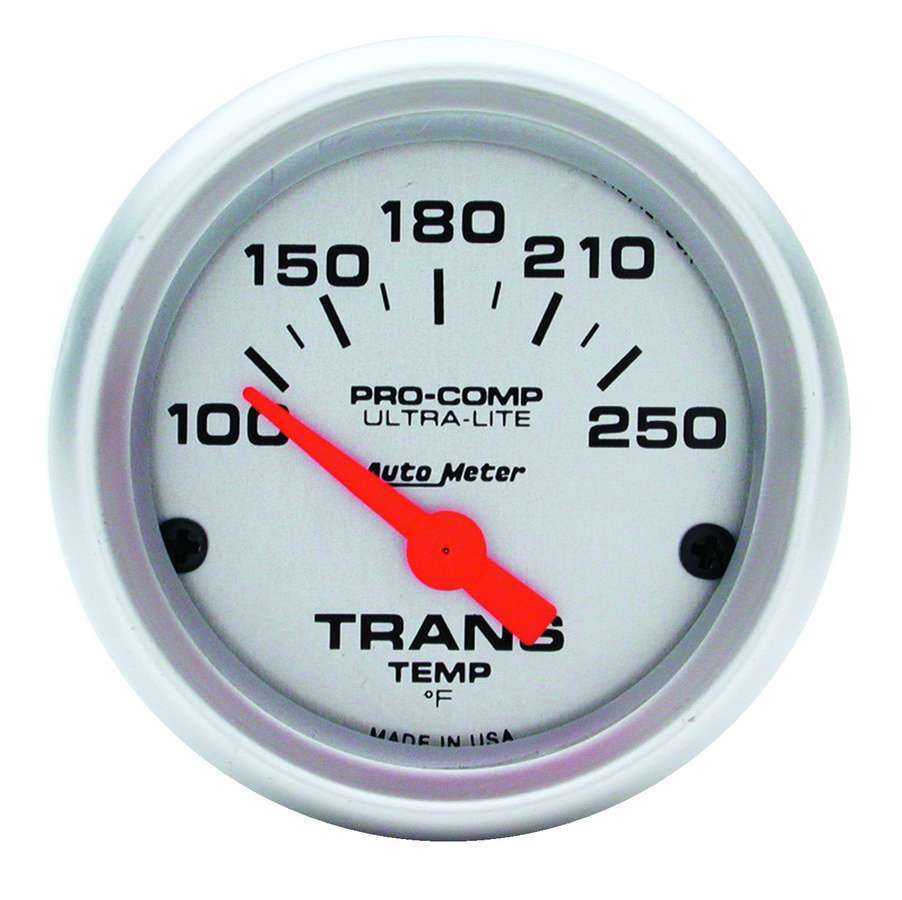Experience teaches veteran racers that maximum performance depends on the close monitoring of water and oil temperatures, oil and fuel pressure, and transmission fluid temperature. Clearly visible temperature and pressure gauges with warning lights can provide critical information about issues before serious engine or transmission damage occurs.
Every engine has an optimum OIL PRESSURE that will provide peak performance and the durability needed to finish the race successfully. A reliable rule of thumb calls for 10 PSI of oil pressure for every one thousand RPM. For example, an oil pressure reading of 60 PSI at 6,000 RPM is sufficient for the average small block racing engine (IF it has an efficient oiling system).
Most often, the stock oiling system must be modified or enhanced for efficient oiling at higher RPM. Keeping tabs with an accurate oil pressure gauge is imperative, because oil pressure normally fluctuates up or down, depending upon engine and outside air temperatures. For example, an engine with 60 PSI of oil pressure at 6,000 RPM on a 95°F day may register 65 PSI. at the same RPM on a cooler 60°F evening.
In addition to a reliable gauge, racers often use an auxiliary warning light wired to a sending unit which activates the light when the oil pressure drops to a dangerous level. This highly visible alert can grab a racer’s attention quickly in the event of a problem.
Keep in mind, too, that maintaining a higher oil pressure than necessary wastes horsepower because of the larger oil pump gears and stiffer pressure relief springs in high-pressure pumps.
Higher oil pressure subsequently creates increased OIL TEMPERATURE, because the oil is being forced to compress as it flows through the galleries. Air temperature can also affect oil temperature.
Ideal operating oil temperatures are between 230°F and 260°F, where oil flows the most freely and provides the best lubrication. Petroleum-based engine oil breaks down very rapidly and loses lubricating properties as temperatures near 285°F. Synthetic motor oil holds up better in higher temperatures and provides better engine endurance under extreme heat.
The oil temperature gauge should be mounted near the oil pressure gauge, and a warning light here would also be a good idea.

Engine WATER TEMPERATURE affects oil pressure and oil temperature, so it’s quite logical that an accurate water temperature gauge is likewise an absolute necessity. As water temperature increases, oil pressure drops and oil temperature rises. Smart racers use auxiliary engine oil coolers. In fact, many aluminum race radiators have built-in engine oil coolers.
Ideal water temperature varies, depending upon the engine and the type of racing performed. Past experience and/or dyno testing help determine the ideal water temperature range for a particular setup. Dyno tests on a small block Chevy, for example, show that this engine generates maximum horsepower between 200-220°F.
Drag racers preheat their cars in the pits to warm not only the engine, but also the transmission and rear end. Quickly pouring water through the cooling system just prior to entering the staging lanes will significantly back down the temperature of the intake manifold, while engine oil and transmission fluid remain warm.
Circle track racers also preheat engines to around 190°F prior for qualifying, and they may also block the air inlet with racer’s tape to build additional heat in the engine. The water temperature may rise to around 210°F during actual qualifying.
Determining the correct FUEL PRESSURE is as much of a science as any of the areas we’ve discussed so far. Dyno tests have proven that there is an ideal fuel pressure for each particular application. Most carbureted drag and circle track race cars run best between 6-8 PSI, while a typical gas-powered fuel-injected vehicle requires 35-50 PSI. Note that the fuel jets must never be uncovered or performance will suffer.
TRANSMISSION TEMPERATURE should also be closely monitored, especially by drag racers. Prior to racing, drivers may “foot stall”, or activate the trans brake, to warm the transmission in the pits to an ideal operating temperature between 175°F and 225°F. Automatic transmissions shift best, and torque converters provide maximum stall speed, when they are operated in this temperature range. Transmission fluid begins to break down at 240°F.

Bottom line? Install a good set of gauges,and be aware of what are considered
“normal” operating pressures and temperatures under varying conditions.